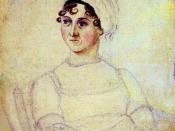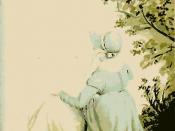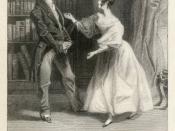The major themes present in Jane Austen's Pride and Prejudice can be perceived by simply reading the title of the novel. Mr. Fitzwilliam Darcy and Miss Elizabeth Bennet illustrated through their thoughts, actions, and words how a person can exhibit pride or prejudice and then change his or her manners and eliminate that pride or prejudice. Throughout the novel, Darcy displayed pride while Elizabeth demonstrated prejudice. There were many situations in the story when Darcy's pride and Elizabeth's prejudice interacted and revealed the personalities of the two characters.
Darcy and Elizabeth first encountered each other at a ball. Here, Darcy was "discovered to be proud, to be above his company, and above being pleased" (Austen 7). Most of the partygoers found him to be unpleasant and disagreeable. This event is was where Elizabeth's prejudice against Darcy was formed. She judged him based on the first impression he gave and did not wait until she got to know him.
The ball established the themes of the novel and initiated the future relationship of Darcy and Elizabeth.
Mr. Darcy was commonly viewed as a proud and irritable man. Mr. Wickham points out to Elizabeth that "almost all his actions may be traced to pride; and pride has often been his best friend" (Austen 70). Darcy's pride, as pointed out by Miss Lucas, seemed to be a result of his fortune and high social status. For many characters, this explanation was acceptable and Darcy's pride was dismissed in future events. Elizabeth however, could not dismiss his pride because he had hurt her own pride and feelings during the ball. Darcy exhibited this pride when he says that Elizabeth is "tolerable; but not handsome enough to tempt me" (Austen 8).
According to Elizabeth, the greatest misfortune of all would be "To find a man...


